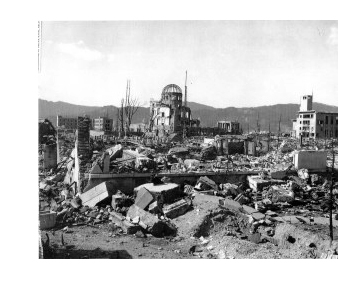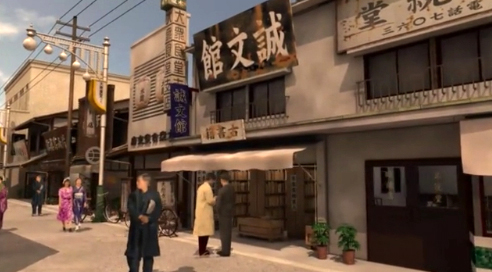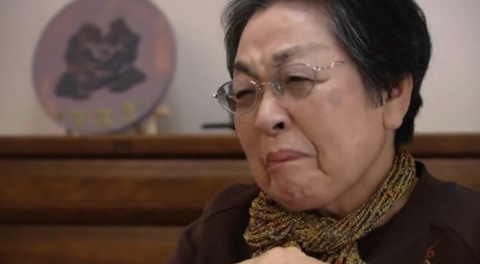|
|
Reviewed by Glenn Erickson
A modest but handsomely produced documentary, Message from Hiroshima marks the 70th anniversary of the bombing of Hiroshima with something we've not seen frequently here in the states: first-person testimony by actual bombing survivors. The docu uses some archival film, from sources that are just adequate, but complements its interview material with interesting, expressive digital recreations. I'll explain them a bit later.

The framework for the show is provided directly by its writer-director, Masaaki Tanabe, who by calculation should now be around 79 years old. Like several of the men and women interviewed in his docu, Tanabe wasn't actually in Hiroshima when the bombs fell. As a child of nine years he had been evacuated to another location; his house was directly next to the Hiroshima Prefectural Industrial Promotion Hall, the distinctive domed building targeted by the Enola Gay for the airburst. Like the other survivors, Tanabe can walk in the Hiroshima Peace Memorial Park that now surrounds the A-Bomb Dome, the ruins of which have been preserved, and point to exactly where his house was. As do several of the spokespeople, Tanabe states that the bones of his mother and small brother, who were probably eating breakfast when the bomb hit, are in the ground below him. If he were allowed, he would dig for them.
The film speaks some about the hibakusha, the survivors that suffered burns or long-term radiation effects. Many were discriminated against because of the social stigma associated with a 'sordid' episode that bigoted Japanese preferred to forget. (A good movie about this is Shohei Imamura's Black Rain.) Tanabe talks about being bullied as a child, because he was an orphan of this 'socially inconvenient event.'

But Message from Hiroshima doesn't concentrate on the horror, or the director's personal bitterness. Instead, it uses photos and graphics to reconstruct the homes of the survivor-interview subjects. Before & after photos visually locate where in the rubble stood specific homes, which often doubled as places of business. Handsome digital reconstructions give us a look at the vibrant, bustling little shopping districts that were in the immediate downtown area of Hiroshima, tucked between several converging rivers. Just as Masaaki's house was right next to the A-Bomb dome, other people's shops were just across the river, or a block away down a charming walkway. The entire area was simultaneously crushed by the shock wave and incinerated by the intense heat.
The interviewees describe their experiences, some of which are illustrated by art drawn by survivors and presumably on exhibition at the memorial, as seen in the French film Hiroshima mon amour. The families are big, with proud mothers and fathers posing with children that display a range of personalities. Some of the fathers pose in military uniforms; most able men were off fighting. By 1945 untold hundreds of thousands had already fallen.

The show comes to life with the colorful recreations of the houses and streets, which comprise a little lesson on how the petit bourgeoisie of Hiroshima lived. One survivor talks about her family's shoe store, and what we see is a charming corner shop open to the air, with dozens of wooden clogs and woven thong slippers on view. The houses have screens and partitions that allow rooms to be combined for gatherings, or opened to the outside weather. The buildings all appear to be made of wood.
Another interviewee describes her childhood with a family that had been photographers for several generations. The surviving photos were presumably located somewhere other than Hiroshima. Another man who spent his childhood in Hiroshima remembers two movie theaters, one that showed American films and another for domestic pictures. He says that he saw Akira Kurosawa's Sanshiro Sugata in Hiroshima.

Tanabe's digital recreations are moving shots that drift slowly, respectfully through the houses. When he moves down a shopping lane, photo images of representative citizens and shoppers, men, women and children, are integrated into the 3-D dioramas. We notice that the civic leaders enforced a motif of little decorations every few feet, giving the shopping district a friendly and distinctive look. They could be hanging lights, or just ornamental silver balls. Masaki has achieved his goal of bringing the district back to life.
Of course, the modern-day footage reminds us that the memorial and park are also a living grave for the thousands obliterated by the blast. All the survivors reiterate that this must never be allowed to happen again. As that admittedly important message is heard in every bomb-themed docu, we're more interested in the evocation of the city as it was before. By showing us the enormity of what was lost -- not just a town, but a downtown community of 80,000 people -- Message from Hiroshima has a special value.

The photos and digital recreations look very nice, but Tanabe's clips of newsreel footage were culled from inferior sources. As we've seen that footage all too often, he might have found a substitution for it -- some of the best films communicate the horror of events indirectly, as with Alain Resnais' Night and Fog.
Actor George Takei reads Tanabe's narration with dignity and feeling. More than once the words describe Hiroshima as 'the first atomic bomb explosion in history' when in reality it was the second. I assume what was meant was the first hostile atom attack on a city. But because there are now equally hostile viewers looking for excuses to withhold their sympathy, the translation mistake could be used to question the docu's overall accuracy. Almost all of the survivors leave the issue of the bombing at, 'it must not happen again.' Mr. Tanabe's good film communicates best when it makes us comprehend what our bombs obliterated.

Cinema Libre's Message from Hiroshima is a good-looking enhanced widescreen DVD encoding of this colorful documentary. The show is bright and technically polished, image and sound alike.
A trailer is included, along with an impressive photo gallery with more images and diagrams showing the location of homes and shops incinerated by the blast. A six-minute interview with Masaaki Tanabe gives us a serious man who clearly made the show as a labor of devotion. If the IMDB is correct, Tanabe worked special effects on a 2010 comedy about invisibility. Perhaps the special digital visuals, Message from Hiroshima's reason-for-being, are his doing. Associate producers Adam Dykstra and Yuriko Senoo are also associated with professional digital animation as well, however.
Cinema Libre regularly gives us strong, emotional docus advocating challenging political positions. Message from Hiroshima is a pro- people, pro- humanity message movie.

On a scale of Excellent, Good, Fair, and Poor,
Message from Hiroshima Blu-ray
rates:
Movie: Good
Video: Good excepting some rough newsreel clips
Sound: Good
Supplements: Trailer, photo gallery, director featurette
Deaf and Hearing-impaired Friendly?
YES; Subtitles: English, but only for Japanese dialogue; ALL is covered with closed-captioning (CC)
Packaging: Keep case
Reviewed: Aiugust 5, 2015

Text © Copyright 2015 Glenn Erickson
See more exclusive reviews on the Savant Main Page.
The version of this review on the Savant main site has additional images, footnotes and credits information, and may be updated and annotated with reader input and graphics.
Return to Top of Page
|


